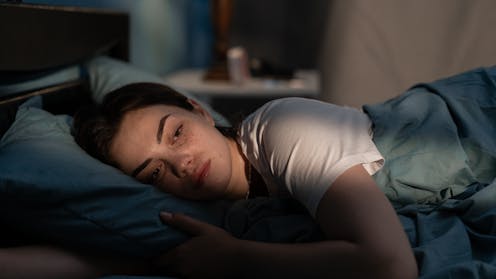Cannabinoid products may reduce total sleep time in adults with insomnia: new study
- Written by Camilla Hoyos, Senior Lecturer in the Centre for Sleep and Chronobiology, Macquarie University

You might have heard cannabis and cannabinoid products can help people sleep. Data shows one of the top reasons people use cannabis is to help them sleep.
But there’s a dearth of high-quality research on how medicinal cannabis products actually affect sleep.
To find out more, our research team conducted a small pilot study involving 20 people. We wanted to compare how they slept after using a medicinal cannabis product, compared to a placebo.
The results of the study, published today in the Journal of Sleep Research, surprised us.
We found a single oral dose of a cannabinoid product decreased total sleep time and the time spent in REM sleep (rapid eye movement, which is when we tend to dream). We didn’t observe any change in objective alertness the day after the treatment.
Our study is small and only measured the effect of a single dose, so more research is clearly needed.
But overall, our findings suggest cannabinoids may acutely influence sleep, primarily by suppressing REM sleep, without noticeable next-day impairment.
What we did
All 20 people (16 of whom were female) involved in our study had a clinical diagnosis of insomnia disorder.
This means they reported having challenges falling asleep and/or maintaining sleep and that these disturbances impact day-to-day functioning socially, at work, or in other important areas of life.
The average age of our study participants was about 46 years.
At our lab, the study participants were interviewed by a doctor and had their medical history taken. All participants also underwent an overnight diagnostic sleep study. This was done to confirm their sleeplessness was truly insomnia and not other conditions such as sleep apnoea.
Once the participant was able to start the study, they were asked to sleep for two nights at our lab, with at least one week between those two visits.
On one of their visits, they were given a placebo.
On the other, they were given a single oral dose of a medical-grade cannabis oil containing 10 mg THC (tetrahydrocannabinol, the compound responsible for the psychoactive effects of cannabis) and 200 mg CBD (cannabidiol, which does not produce a “high”).
Using a product with a precise, known dose ensures the results are relevant to what doctors in Australia are already prescribing.
The order in which participants received either the treatment or the placebo was randomised, so they didn’t know which one they were taking.
After taking either the treatment or the placebo, they slept at our lab while wearing a special cap with 256 monitors on it. This high-density electroencephalogram or EEG allowed us to record the electrical activity of the brain while the person slept.
The next morning, after they either woke or were woken, they performed a driving simulation test around the time of their normal morning commute.
They also underwent a test that assessed their ability to stay awake in a quiet, dimly lit environment. To track their alertness throughout the day, they repeated this test four times while wearing the high-density EEG cap. This was so we could test their alertness the day after either the treatment or the placebo.
What we found
Our results were not what we expected.
We found the THC/CBD treatment decreased total sleep time by an average of 24.5 minutes. This was largely driven by a significant impact on REM sleep (the phase associated with dreaming), which not only decreased by an average of 33.9 minutes but also took significantly longer for participants to enter. The treatment also offered no benefit in helping participants stay asleep throughout the night.
Perhaps most intriguingly, this objective worsening of sleep wasn’t reflected in the participants’ own perceptions; they reported no change in their subjective sleep quality. This disconnect continued into the next day.
While participants noted feeling slightly more sleepy after the treatment, their objective alertness – measured by their ability to stay awake in a quiet, dimly lit room – was reassuringly unchanged, as was their cognitive and simulated driving performance.
This leads to a crucial question: if a single dose produces these changes, what are the cumulative effects on a person’s sleep after weeks, months, or years of nightly use?
We simply don’t have the answers yet, especially with a medical-grade cannabis product.
A growing body of research
Our findings underscore a significant gap between the widespread public perception of cannabis for sleep and the complex scientific reality. As highlighted by a review we published in the journal Current Psychiatry Reports, the evidence base remains thin.
We reviewed 21 recent studies (published between 2021 and 2024) of cannabinoids being used for insomnia, subjective sleep impairment, obstructive sleep apnoea, rapid eye movement sleep behaviour disorder, and restless legs syndrome.
We found that, despite its widespread use, there’s not enough research yet to support the use of medical cannabis to treat sleep disorders.
This is why this kind of research is so vital. It provides the first pieces of a much larger puzzle.
To give doctors and patients the clear guidance they need, there is an urgent need for adequately funded, well-designed clinical trials with larger sample sizes and longer treatment durations to truly understand the long-term impacts of medicinal cannabis on sleep and daytime functioning.
Authors: Camilla Hoyos, Senior Lecturer in the Centre for Sleep and Chronobiology, Macquarie University



















